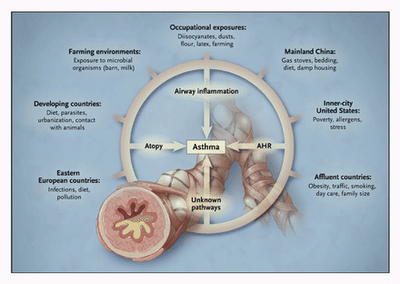In any case, about 20 million people in the United States have asthma today, including at least 6 million children, and 5,000 people a year die from it. Children in the inner cities seem to be especially hard hit, with exposure to cockroaches and diesel fumes suspected as the culprits. But the cause is not known for sure.The article discusses some reasons for the increased prevalence of asthma. Diet, obesity, exposure to allergins and air pollution and my favorite topic the hygiene hypothesis
One theory that has received attention recently is the “hygiene hypothesis,” the idea that children today are raised in homes that are too clean and that asthma is somehow caused by the lack of exposure to infections and bits of microbes early in life. Under this theory, germs are supposed to help the immune system develop normally, and without them the system may overreact to other substances in the environment, producing allergies and asthma.The entire NYT article is based on paper recently published in the New England Journal of Medicine entitled: The Asthma Epidemic by Waltraud Eder, M.D., Markus J. Ege, M.D., M.P.H., and Erika von Mutius, M.D. (2006, 355(21):2226-2235).
There is some evidence to support the idea. Studies find that children raised on farms are less prone than others to asthma, maybe because they are exposed to plenty of microbes in barns and stables. But the connection is still not fully understood, and some viral infections clearly make asthma worse.
This is figure 4 from the journal article. It shows the various ways in which different types of exposures interact with different economic living conditions, resulting in variations in the prevalence of asthma.

Figure 4. Effect of the Interaction between Various Types of Exposures and Various Genetic Backgrounds in a Range of Racial and Ethnic Groups on the Prevalence of Asthma through Pathways Involving Atopy, Airway Inflammation, Airway Hyperresponsiveness (AHR), or Other, Unknown Factors.
Unfortunately, both articles give short shrift to the involvement of helminth infections in the hygiene hypothesis.
Chronic infestation with helminths may also confer protection, but short-lived episodes of infestation may exacerbate atopic disorders.This article: Allergy, Parasites, and the Hygiene Hypothesis published in "Science" provides the reasoning behind helminth infections and the hygiene hypothesis. Full text is not freely available but since it's in "Science" you should be able to find it in your local library.
An interesting article entitled Eating Dirt by Gerald N. Callahan can be found here at the CDC.
A few hygiene hypothesis links:
http://www.pbs.org/wgbh/evolution/library/10/4/l_104_07.html
http://www.respiratoryreviews.com/jan03/rr_jan03_hygiene.html
http://www.ucsfhealth.org/childrens/health_library/reuters/2005/
09/20050923elin024.html
http://www.sciencenews.org/pages/sn_arc99/8_14_99/bob2.htm
http://www.mult-sclerosis.org/news/Jul2000/TheHygieneHypothesis.html

2 comments:
Very nice overview of the NYT/NEJM piece.
There was an interesting sidelight on the hygiene hypothesis earlier this year with the Increased Levels of IgE and Autoreactive, Polyreactive IgG in Wild Rodents study.
It is anecdote - but I was interested in the account of this chap who was so desperate about his asthma and hayfever that he deliberately acquired hookworm in an attempt to treat it. I did give myself the horrors recently by wondering if a helminth might down-regulate aberrant airway inflammation.
I don't know if anybody has done any comparative studies but asthma and allergies are becoming more prevalent in Africa.
Regards - Shinga
Joel Weinstock has already reported some success in treating people with intestinal bowel disease by infecting them with Trichuris suis.
http://www.int-med.uiowa.edu/News/Stories02.asp?displayID=35
Post a Comment